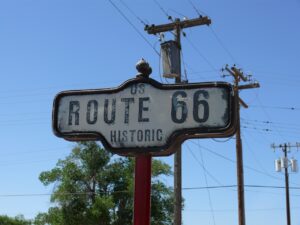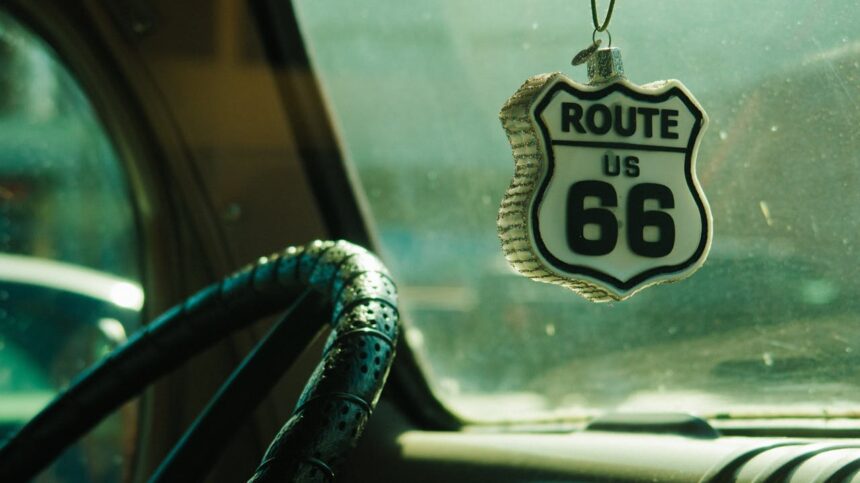Introduction to Route 66: A Brief History and Its Significance in American Road Trips
The Birth of Route 66
Route 66, often referred to as the “Mother Road,” was established on November 11, 1926. Spanning approximately 2,448 miles from Chicago, Illinois, to Santa Monica, California, this iconic highway connected the Midwest to the West Coast, providing a crucial link for migrating families during the Dust Bowl era. It’s not just a road but a symbol of freedom and adventure, inviting you to explore the heart of America.

Cultural Impact
Over the years, Route 66 has been immortalized in music, literature, and film, becoming a cultural icon representing the quintessential American road trip. Songs like Bobby Troup’s “Get Your Kicks on Route 66” and Pixar’s “Cars” have cemented their place in popular culture.
Modern-Day Appeal
Despite being decommissioned as an official U.S. Highway in 1985, Route 66 continues to attract travel enthusiasts and adventure seekers from around the world. Its historical significance, combined with a plethora of quirky attractions and natural wonders, offers a unique journey that’s waiting to be experienced. It’s not just a road trip but a chance to create unforgettable memories and discover the heart of America.
Must-See Stops Along the Way: Iconic Landmarks, Quirky Attractions, and Natural Wonders
Iconic Landmarks
- Cadillac Ranch (Amarillo, Texas): This public art installation features ten Cadillacs buried nose-first in the ground. Visitors are encouraged to add their own spray paint designs, making it a constantly evolving masterpiece.
- The Gateway Arch (St. Louis, Missouri): Standing at 630 feet, this monument symbolizes the westward expansion of the United States. Take a tram ride to the top for breathtaking views of the Mississippi River and downtown St. Louis.
- Petrified Forest National Park (Arizona): Known for its vast deposits of petrified wood, this national park offers a stunning glimpse into prehistoric times. Wander through the Rainbow Forest Museum and take scenic drives to witness the ancient, fossilized trees and the colorful Painted Desert.
- Santa Monica Pier (Santa Monica, California): This historic pier marks the western end of Route 66. Featuring an iconic Ferris wheel, an amusement park, and an aquarium, it’s a perfect place to celebrate the completion of your journey with a sunset over the Pacific Ocean.
- Wigwam Motel (Holbrook, Arizona): One of the last remaining examples of early roadside Americana, this motel offers a unique lodging experience where guests sleep in tipi-shaped rooms. Enjoy a nostalgic stay and reflect on the golden age of American road trips.
Quirky Attractions
- The Blue Whale of Catoosa (Catoosa, Oklahoma): Originally built as a surprise anniversary gift, this giant blue whale has become a beloved roadside attraction. It’s a perfect spot for a picnic and some fun photos.
- The Wigwam Motel (Holbrook, Arizona): This unique lodging option offers a nostalgic glimpse into mid-20th-century roadside America by staying in one of the 15 concrete teepees.
- The World’s Largest Rocking Chair (Fanning, Missouri): Standing over 42 feet tall, this enormous rocking chair is a whimsical roadside attraction, providing a perfect photo opportunity. Stop by and marvel at the sheer scale of this giant piece of furniture.
- The Gemini Giant (Wilmington, Illinois): One of the iconic “Muffler Men” statues, the Gemini Giant stands guard at the Launching Pad Drive-In. Decked out in a space helmet and holding a rocket, this towering figure is a charming nod to the space age.
- The Totem Pole Park (Foyil, Oklahoma): Home to the world’s most enormous concrete totem pole, the park features a collection of colorful, folk-art totem poles created by Ed Galloway. Stroll through the park to admire these vibrant, hand-carved structures that provide a unique glimpse into American art.
- The Bottle Tree Ranch (Oro Grande, California): Created by artist Elmer Long, this quirky site features hundreds of “trees” made from glass bottles and other found objects. Walk among the glittering bottle trees and enjoy the whimsical and artistic atmosphere of this desert oasis.
Natural Wonders
- The Petrified Forest National Park (Arizona): Explore the ancient, fossilized trees that have become stone over millions of years. The park also features stunning badlands and archeological sites.
- Grand Canyon National Park (Arizona): While slightly off the main Route 66 path, this natural wonder is worth the detour. The awe-inspiring views and hiking opportunities make it a once-in-a-lifetime experience.
- Meteor Crater (Winslow, Arizona): This enormous crater was created by a meteor impact around 50,000 years ago. Measuring over 3,900 feet in diameter and 560 feet deep, it offers a fascinating glimpse into the power of celestial impacts. The visitor center provides educational exhibits and guided rim tours.
- Red Rock State Park (Sedona, Arizona): Known for its stunning red sandstone formations, this state park offers hiking trails, picnic spots, and breathtaking views. The vibrant rock formations, set against the lush greenery and blue skies, make it a photographer’s paradise.
- Mojave National Preserve (California): Spanning over 1.6 million acres, this vast desert preserve features dunes, volcanic formations, and Joshua tree forests. Highlights include the Kelso Dunes, Hole-in-the-Wall, and the Cinder Cone Lava Beds, offering diverse landscapes to explore.
- Devil’s Elbow (Missouri): Located along the Big Piney River, Devil’s Elbow provides scenic views of the rugged Ozark cliffs and a historic steel truss bridge. It’s a picturesque canoeing, fishing, or relaxing spot by the riverbank.
- Painted Desert (Arizona): Adjacent to the Petrified Forest, it stretches for over 160 miles, showcasing a kaleidoscope of colors across its eroded hills and buttes. The hues of red, orange, and purple create a mesmerizing landscape that changes with the sun’s position.
- Meramec Caverns (Missouri): A spectacular network of limestone caves, Meramec Caverns has attracted visitors since the 1930s. The caves offer guided tours through vast underground rooms and stunning formations such as stalactites and stalagmites, providing a captivating subterranean adventure.
Planning Your Route 66 Adventure: Tips for Choosing the Best Time to Travel and the Ideal Itinerary
Best Time to Travel
- Spring and Fall: These seasons offer mild weather, less crowded attractions, and stunning natural scenery. Temperatures are generally comfortable, making it an ideal time for outdoor activities.
- Summer: While summer is the peak travel season, it can be quite hot, especially in the Southwestern states. However, longer daylight hours provide more time for exploration.
- Winter: Traveling during winter can offer a quieter experience, but be prepared for varying weather conditions, mainly snow in the Midwest and colder temperatures.
Ideal Itinerary
- Week 1: Chicago to Oklahoma City
- Day 1-2: Explore Chicago, visit the Route 66 starting point, and head to Springfield, Illinois.
- Day 3-4: Visit St. Louis and the Gateway Arch, then continue to Springfield, Missouri.
- Day 5-7: Journey through Tulsa and Catoosa, Oklahoma, ending the week in Oklahoma City.
- Week 2: Oklahoma City to Santa Monica
- Day 8-9: Explore Amarillo, Texas, and visit Cadillac Ranch.
- Day 10-11: Discover Albuquerque, New Mexico, and its unique culture.
- Day 12-13: Visit Arizona’s Petrified Forest and Grand Canyon.
- Day 14: Conclude your journey in Santa Monica, California, with a visit to the Route 66 End of the Trail sign.

The Ultimate Packing List: Essentials for a Comfortable and Enjoyable Road Trip
Travel Documents and Essentials
- Driver’s License and Vehicle Registration: Ensure your documents are up-to-date and easily accessible.
- Insurance Information: Carry proof of auto insurance and any necessary travel insurance.
- Roadside Assistance Membership: Enroll in a roadside assistance program for peace of mind.
Comfort and Safety Items
- First Aid Kit: Include bandages, antiseptics, pain relievers, and personal medications.
- Travel Pillow and Blanket: This is for added comfort during long stretches of driving.
- Reusable Water Bottle: Stay hydrated, especially in hot climates.
Navigation and Technology
- GPS Device or Smartphone with Maps App: Ensure you have reliable navigation tools, whether digital or traditional paper maps.
- Portable Charger and Power Bank: Keep your devices charged and ready.
- Camera: Capture memories along the way with a good-quality camera or smartphone.
Clothing and Personal Items
- Layered Clothing: Prepare for varying weather conditions by packing layers.
- Comfortable Shoes: Essential for exploring attractions and natural sites.
- Sunglasses and Sunscreen: Protect yourself from the sun, especially in open and sunny areas.
Entertainment and Leisure
- Books or E-Reader: Great for relaxing during downtime.
- Travel Journal and Pen: Document your journey and experiences.
- Playlist or Audiobooks: Make long drives more enjoyable with your favorite tunes or stories.
Where to Stay: Accommodation Options Ranging from Historic Motels to Modern Hotels
Historic Motels
- The Blue Swallow Motel (Tucumcari, New Mexico): Step back in time at this beautifully restored 1939 motor court, known for its vintage neon sign and cozy rooms.
- The Munger Moss Motel (Lebanon, Missouri): This classic Route 66 motel offers retro charm and friendly hospitality, perfect for a nostalgic overnight stay.
Modern Hotels
- Hotel Indigo (Los Angeles, California): Located near the end of Route 66, this contemporary hotel offers luxury amenities and stunning city views.
- 21c Museum Hotel (Oklahoma City, Oklahoma): This hotel combines modern art with boutique accommodations also providing a unique and upscale experience.
Unique Stays
- El Rancho Hotel (Gallup, New Mexico): Known as the “Home of the Movie Stars,” this historic hotel has hosted numerous Hollywood celebrities and offers rustic charm.
- Shamrock Court (Sullivan, Missouri): Experience a piece of Route 66 history with a stay at this meticulously restored motor court.
Dining Along the Route: Recommendations for the Best Local Eats and Iconic Diners
Classic Diners
- Lou Mitchell’s (Chicago, Illinois): Start your journey with a hearty breakfast at this iconic diner, which has been serving travelers since 1923.
- The Big Texan Steak Ranch (Amarillo, Texas): Famous for its 72-ounce steak challenge, this restaurant offers a true taste of Texan hospitality.
Local Favorites
- Oklahoma Joe’s Bar-B-Cue (Kansas City, Kansas): Savor mouthwatering barbecue at this award-winning joint, known for its ribs and burnt ends.
- The Turquoise Room (Winslow, Arizona): Located in La Posada Hotel, this restaurant offers Southwestern cuisine with a contemporary twist.
Unique Eateries
- Dell Rhea’s Chicken Basket (Willowbrook, Illinois): Enjoy crispy fried chicken at this historic restaurant, a Route 66 staple since 1946.
- Cafe 66 (Williams, Arizona): This charming eatery offers delicious comfort food and a warm, welcoming atmosphere.
Budgeting for Your Trip: Cost Estimates and Money-Saving Tips
Cost Estimates
- Accommodation: Depending on your preferences, budget options range from $50 to $100 per night, while luxury stays can cost upwards of $200 per night.
- Food: Plan for an average of $30-$50 per day per person, including meals at diners, local restaurants, and occasional splurges.
- Fuel: Estimate fuel costs based on your vehicle’s mileage and gas prices. Route 66 spans approximately 2,448 miles, so factor in additional miles for detours and exploration.
- Attractions: Allocate funds for entrance fees to national parks, museums, and unique attractions. Budget around $100-$200 for the entire trip.
Money-Saving Tips
- Book in Advance: Secure accommodations and tickets for popular attractions early to take advantage of discounts and availability.
- Travel Off-Peak: Consider traveling during shoulder seasons (spring and fall) to avoid peak rates and crowds.
- Pack Snacks and Drinks: Save money on dining by bringing along snacks and drinks for the road.
Navigating the Route: GPS vs. Traditional Maps, Cell Phone Reception, and Safety Tips
GPS vs. Traditional Maps
- GPS Devices and Apps: Modern GPS devices and smartphone apps, such as Google Maps and Waze, offer real-time navigation, traffic updates, and points of interest.
- Traditional Maps: Carry a reliable paper map or Route 66 guidebook as a backup. They provide a fun, nostalgic touch and can be invaluable in areas with limited cell reception.
Cell Phone Reception
- Coverage: While significant cities and towns along Route 66 generally have good cell phone coverage, remote areas may need more reception. Plan accordingly and inform someone of your travel itinerary.
- Offline Maps: Download offline maps and essential travel information before you hit the road to ensure you have access even in areas without cell service.
Safety Tips
- Regular Vehicle Maintenance: Ensure your vehicle is in top condition before embarking on your journey. Check tires, oil, brakes, and fluid levels.
- Rest Stops: Take regular breaks to rest and stretch. Fatigue can impair driving, so prioritize safety and well-being.
- Emergency Kit: Pack an emergency kit with items like a flashlight, jumper cables, spare tire, and essential tools.
Making Memories: Advice on How to Capture and Document Your Road Trip
Photography Tips
- Golden Hour: Capture stunning photos during the golden hour (shortly after sunrise and before sunset) for the best lighting.
- Landmarks and Signs: To document your journey, take pictures of iconic Route 66 signs, landmarks, and quirky attractions.
- Candid Shots: Capture candid moments and interactions to tell a more authentic story of your adventure.
Journaling and Blogging
- Travel Journal: Keep a travel journal to document your experiences, thoughts, and reflections.
- Blogging: Start a travel blog to share your journey with friends and family. Also, Include detailed descriptions, photos, and tips for future travelers.
Social Media
- Instagram and Facebook: Share highlights of your journey on social media platforms to inspire others and connect with fellow travel enthusiasts.
- Hashtags: Use relevant hashtags like #Route66, #RoadTrip, and #TravelAdventures to reach a wider audience and discover other travelers’ experiences.
Conclusion
Route 66 remains an enduring symbol of American freedom, adventure, and nostalgia. Its rich history, diverse attractions, and unique charm continue to captivate travelers from around the world. By embarking on this journey, you’ll not only create lasting memories but also become part of a storied tradition that has inspired countless adventurers before you.
Whether you’re a seasoned road tripper or a first-time traveler, the Ultimate Road Trip Guide for Route 66 provides everything you need to plan an unforgettable adventure. So pack your bags, hit the open road, and get ready to discover the magic of the Mother Road.
Frequently Asked Questions (FAQs)
Q. How long does it take to drive Route 66?
The entire journey across Route 66 is approximately 2,448 miles and can take around two weeks if you travel at a leisurely pace and make stops at various attractions along the way. However, the duration can vary based on your schedule and how many detours you take.
Q. What is the best time of year to travel Route 66?
The best times to travel Route 66 are during the spring (April to June) and fall (September to October). These seasons offer milder weather, less crowded attractions, and picturesque scenery. Summer can be famous, but it also brings higher temperatures and more tourists.
Q. Is Route 66 suitable for families?
Route 66 is a fantastic destination for family road trips. The journey offers a variety of attractions suitable for all ages, from kid-friendly museums and parks to quirky roadside diners and scenic landmarks. Planning and ensuring the car is comfortable can make the trip enjoyable for both adults and children alike. Many stretches of the route pass through small towns where you can experience local culture and hospitality, making it an educational and memorable experience for the entire family.
Q. Can I drive Route 66 in an RV?
Yes, Route 66 can be driven in an RV. However, be mindful of the size of your vehicle as some sections of the road, especially in urban areas, can be narrow or difficult to navigate. There are many RV parks and campgrounds along the route for convenient overnight stays.
Q. What are the top places of attraction on Route 66?
Route 66 boasts iconic attractions that capture the Mother Road’s spirit. Highlights include Cadillac Ranch in Amarillo, Texas, where visitors can spray paint partially buried Cadillacs. The Gateway Arch in St. Louis offers stunning architecture and city views. Be sure to check out Arizona’s Painted Desert and Petrified Forest National Park for their incredible landscapes and ancient trees. Wigwam Motels in Holbrook, Arizona, and San Bernardino, California, offer unique stays in teepee-shaped rooms. Cap off your journey at Santa Monica Pier in California, the official end of Route 66, with its historic carousel and lively atmosphere.
Q. What should I pack for a Route 66 road trip?
Pack essentials such as a good road atlas or map, a GPS device, plenty of water, snacks, comfortable clothing, and a first-aid kit. A camera is needed to capture your adventure. Also, consider bringing a cooler for perishable food items. Packing an emergency kit, including a flashlight, jumper cables, and essential tools, is also wise.







